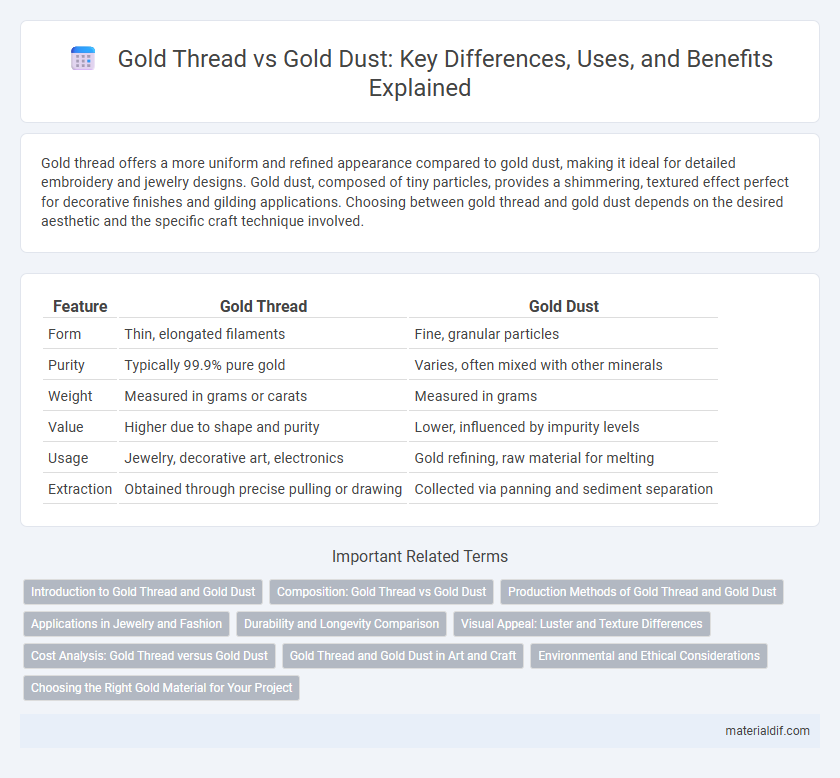Gold thread offers a more uniform and refined appearance compared to gold dust, making it ideal for detailed embroidery and jewelry designs. Gold dust, composed of tiny particles, provides a shimmering, textured effect perfect for decorative finishes and gilding applications. Choosing between gold thread and gold dust depends on the desired aesthetic and the specific craft technique involved.
Table of Comparison
| Feature | Gold Thread | Gold Dust |
|---|---|---|
| Form | Thin, elongated filaments | Fine, granular particles |
| Purity | Typically 99.9% pure gold | Varies, often mixed with other minerals |
| Weight | Measured in grams or carats | Measured in grams |
| Value | Higher due to shape and purity | Lower, influenced by impurity levels |
| Usage | Jewelry, decorative art, electronics | Gold refining, raw material for melting |
| Extraction | Obtained through precise pulling or drawing | Collected via panning and sediment separation |
Introduction to Gold Thread and Gold Dust
Gold thread and gold dust are two distinct forms of gold used in various industries and crafts, each with unique characteristics and applications. Gold thread consists of fine strands or wires of gold, commonly utilized in embroidery, textiles, and jewelry-making for its flexibility and detailed decorative potential. Gold dust, on the other hand, refers to tiny particles or granules of gold, often employed in mining, refining processes, and some artistic techniques due to its ease of melting and blending.
Composition: Gold Thread vs Gold Dust
Gold thread primarily consists of fine strands of pure or alloyed gold, often twisted or woven to maintain structural integrity and flexibility for decorative use. In contrast, gold dust comprises minute, irregular particles of native gold, typically mixed with mineral impurities or other metals, which require refinement for purity. The compositional difference lies in gold thread's deliberate fabrication into filaments versus gold dust's natural, granular form often found in placer deposits.
Production Methods of Gold Thread and Gold Dust
Gold thread is produced through a meticulous process involving the drawing of pure gold into fine wires, which are then twisted or flattened into thin strands used in embroidery and textiles. Gold dust is created by pulverizing gold ore into tiny particles using techniques such as milling and panning or by capturing natural gold particles during mining operations. The production of gold thread requires precision and specialized equipment to maintain the metal's integrity, whereas gold dust collection relies more on mechanical separation and gravity methods.
Applications in Jewelry and Fashion
Gold thread offers a luxurious and durable option for intricate embroidery in high-end fashion and bridal wear, enabling detailed patterns with a rich metallic sheen. Gold dust, often used as a decorative additive in nail art, cosmetics, and resin jewelry, provides subtle shimmer and texture rather than structural design. Both forms enhance jewelry and fashion pieces, with gold thread emphasizing craftsmanship and gold dust emphasizing surface embellishment.
Durability and Longevity Comparison
Gold thread, typically composed of fine gold wrapped around a core material, offers superior durability compared to gold dust, which consists of tiny, loose particles prone to displacement. The structural integrity of gold thread ensures prolonged longevity in applications such as embroidery or jewelry, resisting wear and corrosion more effectively than gold dust. Gold dust's granular form makes it less stable, often leading to faster degradation and loss over time when exposed to environmental factors.
Visual Appeal: Luster and Texture Differences
Gold thread exhibits a smooth, reflective surface with a consistent luster that enhances fabric richness, while gold dust offers a granular, matte finish that creates a subtle sparkle through scattered light reflection. The fine, elongated shape of gold thread gives textiles a sleek, elegant appearance, contrasting with the uneven, textured effect produced by irregularly shaped gold dust particles. Visual appeal depends on application; gold thread suits intricate embroidery with defined shine, whereas gold dust favors diffused shimmer for decorative coatings.
Cost Analysis: Gold Thread versus Gold Dust
Gold thread typically commands a higher price due to its refined manufacturing process and greater purity compared to gold dust, which is often a byproduct with lower purity and mixed impurities. The cost per gram of gold thread reflects its value in jewelry and electronics, where precision and consistency are critical, whereas gold dust is generally valued lower as an industrial material or for melting down. Investment in gold thread offers better quality assurance and resale value, while gold dust may incur additional refining costs that reduce its net worth.
Gold Thread and Gold Dust in Art and Craft
Gold thread, extensively used in embroidery and textile arts, enhances visual richness with its lustrous, flexible strands made by wrapping fine gold leaf around a core thread. Gold dust, comprising tiny gold particles, is favored in painting and gilding for its ability to create intricate highlights and shimmering effects on surfaces. Both materials play crucial roles in traditional and contemporary art, with gold thread offering texture and dimensionality, while gold dust contributes delicate sparkle and fine detail.
Environmental and Ethical Considerations
Gold thread production often involves intensive mining practices that can lead to significant environmental degradation, including habitat destruction and water pollution. Gold dust, typically collected as a byproduct of mining, poses risks such as mercury contamination and soil erosion but may have a smaller ecological footprint if sourced responsibly. Ethical considerations emphasize the importance of traceability and fair labor practices to ensure both gold thread and gold dust are harvested sustainably and without human rights violations.
Choosing the Right Gold Material for Your Project
Gold thread offers durability and a sleek, continuous shimmer for embroidery and jewelry, making it ideal for intricate designs requiring flexibility. Gold dust provides a granular texture with a brilliant sparkle, perfect for adding depth and a luxurious finish to paintings and crafts. Selecting the right gold material depends on the desired visual effect and the project's specific application, balancing durability and aesthetic appeal.
Gold Thread vs Gold Dust Infographic

 materialdif.com
materialdif.com